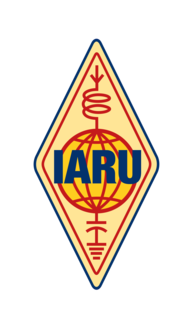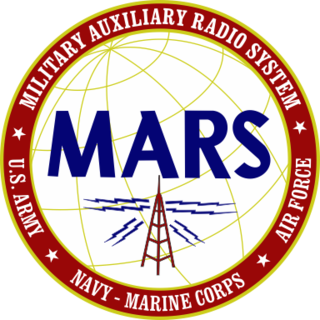Related Research Articles

The International Telecommunication Union, is a specialized agency of the United Nations responsible for all matters related to information and communication technologies. Established in 1865 as the International Telegraph Union, it is one of the oldest international organizations in operation.
Automatic Link Establishment, commonly known as ALE, is the worldwide de facto standard for digitally initiating and sustaining HF radio communications. ALE is a feature in an HF communications radio transceiver system that enables the radio station to make contact, or initiate a circuit, between itself and another HF radio station or network of stations. The purpose is to provide a reliable rapid method of calling and connecting during constantly changing HF ionospheric propagation, reception interference, and shared spectrum use of busy or congested HF channels.
The American Radio Relay League (ARRL) is the largest membership association of amateur radio enthusiasts in the USA. ARRL is a non-profit organization, and was co-founded on April 6, 1914, by Hiram Percy Maxim and Clarence D. Tuska of Hartford, Connecticut. The ARRL represents the interests of amateur radio operators before federal regulatory bodies, provides technical advice and assistance to amateur radio enthusiasts, supports a number of educational programs and sponsors emergency communications service throughout the country. The ARRL has approximately 161,000 members. In addition to members in the US, the organization claims over 7,000 members in other countries. The ARRL publishes many books and a monthly membership journal called QST. The ARRL held its Centennial Convention in Hartford, Connecticut in July 2014.

In the United States and Canada, the Amateur Radio Emergency Service (ARES) is a corps of trained amateur radio operator volunteers organized to assist in public service and emergency communications. It is organized and sponsored by the American Radio Relay League and the Radio Amateurs of Canada.

The International Amateur Radio Union (IARU) is an international confederation of national amateur radio organisations that allows a forum for common matters of concern and collectively represents matters to the International Telecommunication Union (ITU). The International Amateur Radio Union was founded in 1925 and, as of November 2019, it is composed of 172 national member societies.
The 2-meter amateur radio band is a portion of the VHF radio spectrum, comprising frequencies stretching from 144 MHz to 148 MHz in International Telecommunication Union region (ITU) Regions 2 and 3 and from 144 MHz to 146 MHz in ITU Region 1. The license privileges of amateur radio operators include the use of frequencies within this band for telecommunication, usually conducted locally within a range of about 100 miles (160 km).
Shortwave bands are frequency allocations for use within the shortwave radio spectrum. They are the primary medium for applications such as maritime communications, international broadcasting and worldwide amateur radio activity because they take advantage of ionospheric skip propagation to send data around the world. The bands are conventionally stated in wavelength, measured in metres. Propagation behavior on the shortwave bands depends on the time of day, the season and the level of solar activity.

The Military Auxiliary Radio System (MARS) is a United States Department of Defense sponsored program, established as a separately managed and operated program by the United States Army, and the United States Air Force. The United States Navy-Marine Corps program closed in 2015. The program is a civilian auxiliary consisting primarily of licensed amateur radio operators who are interested in assisting the military with communications on a regional and national level when access to traditional forms of communication may no longer be available. The MARS programs also include active duty, reserve, and National Guard units; and Navy, Marine Corps units.

The 60-meter band or 5 MHz band is a relatively new amateur radio allocation, first introduced in 2002, that was originally only available in a few countries, such as the United States, United Kingdom, Norway, Finland, Denmark, Ireland and Iceland. Over a number of years however, an increasing proportion of countries' telecommunications administrations – together with their government and military users – have permitted Amateur Radio operation in the 5 MHz area on a short or longer term basis, ranging from discrete channels to a frequency band allocation.
Saint Lucia's National Emergency Management Organisation (NEMO) is responsible for disaster preparedness and disaster response co-ordination.

Amateur radio international reciprocal operating agreements permit amateur radio operators (hams) from one country to operate a station whilst traveling in another without the need to obtain additional licenses or permits.

In times of crisis and natural disasters, amateur radio is often used as a means of emergency communication when wireline, cell phones and other conventional means of communications fail.

Spectrum management is the process of regulating the use of radio frequencies to promote efficient use and gain a net social benefit. The term radio spectrum typically refers to the full frequency range from 3 kHz to 300 GHz that may be used for wireless communication. Increasing demand for services such as mobile telephones and many others has required changes in the philosophy of spectrum management. Demand for wireless broadband has soared due to technological innovation, such as 3G and 4G mobile services, and the rapid expansion of wireless internet services.
The World Administrative Radio Conference (WARC) bands are three portions of the shortwave radio spectrum used by licensed and/or certified amateur radio operators. They consist of 30 meters (10.100–10.150 MHz), 17 meters (18.068–18.168 MHz) and 12 meters (24.890–24.990 MHz). They were named after the World Administrative Radio Conference, which in 1979 created a worldwide allocation of these bands for amateur use. The bands were opened for use in the early 1980s. Due to their relatively small bandwidth of 100 kHz or less, there is a gentlemen's agreement that the WARC bands may not be used for general contesting. This agreement has been codified in official recommendations, such as the IARU Region 1 HF Manager's Handbook, which states: "Contest activity shall not take place on the 10, 18, and 24 MHz bands."
The history of amateur radio, dates from the dawn of radio communications, with published instructions for building simple wireless sets appearing at the beginning of the twentieth century. Throughout its history, amateur radio enthusiasts have made significant contributions to science, engineering, industry, and social services. Research by amateur radio operators has founded new industries, built economies, empowered nations, and saved lives in times of emergency.

The Global Amateur Radio Emergency Communications Conference or GAREC is a yearly conference held by the International Amateur Radio Union for discussion of amateur radio operation during natural disasters and other emergencies with the motto, "Saving lives through emergency communications". GAREC was first held in Tampere, Finland in 2005, coinciding with the adoption of the Tampere Convention, a globally binding emergency communications treaty that had been signed in Tampere in 1998. In later conferences, the venue has attempted to rotate in sequence through ITU Regions 1, 2 and 3.
An international distress frequency is a radio frequency that is designated for emergency communication by international agreement.
An amateur radio net, or simply ham net, is an "on-the-air" gathering of amateur radio operators. Most nets convene on a regular schedule and specific frequency, and are organized for a particular purpose, such as relaying messages, discussing a common topic of interest, in severe weather, emergencies, or simply as a regular gathering of friends for conversation.

Amateur radio, also known as ham radio, is the use of radio frequency spectrum for purposes of non-commercial exchange of messages, wireless experimentation, self-training, private recreation, radiosport, contesting, and emergency communication. The term "amateur" is used to specify "a duly authorised person interested in radioelectric practice with a purely personal aim and without pecuniary interest;" and to differentiate it from commercial broadcasting, public safety, or professional two-way radio services.
Call signs in Korea are unique identifiers for telecommunications and broadcasting on the Korean peninsula. Call signs are regulated internationally by the ITU as well as nationally in South Korea by the Korea Communications Commission in the Ministry of Information and Communication. Not much is known outside of North Korea how amateur radio is regulated, although a foreign amateur was asked to appear before the "Radio Regulation Board" in 2002. Also, North Korea's Cultural Relations with Foreign Countries recently issued an operating permit, which was countermanded by the Ministry of Telecommunications and Posts.
References
- ↑ The Tampere Convention on the Provision of Telecommunication Resources for Disaster Mitigation and Relief Operations http://www.iaru.org/tampere-convention.html Accessed 20 April 2016.
- ↑ "Tampere Convention Eases International Emergency Telecommunications" in The ARRL Letter Vol. 24, No. 04, 28 January 2005 http://www.arrl.org/arrlletter/05/0128/ Accessed 12 May 2008